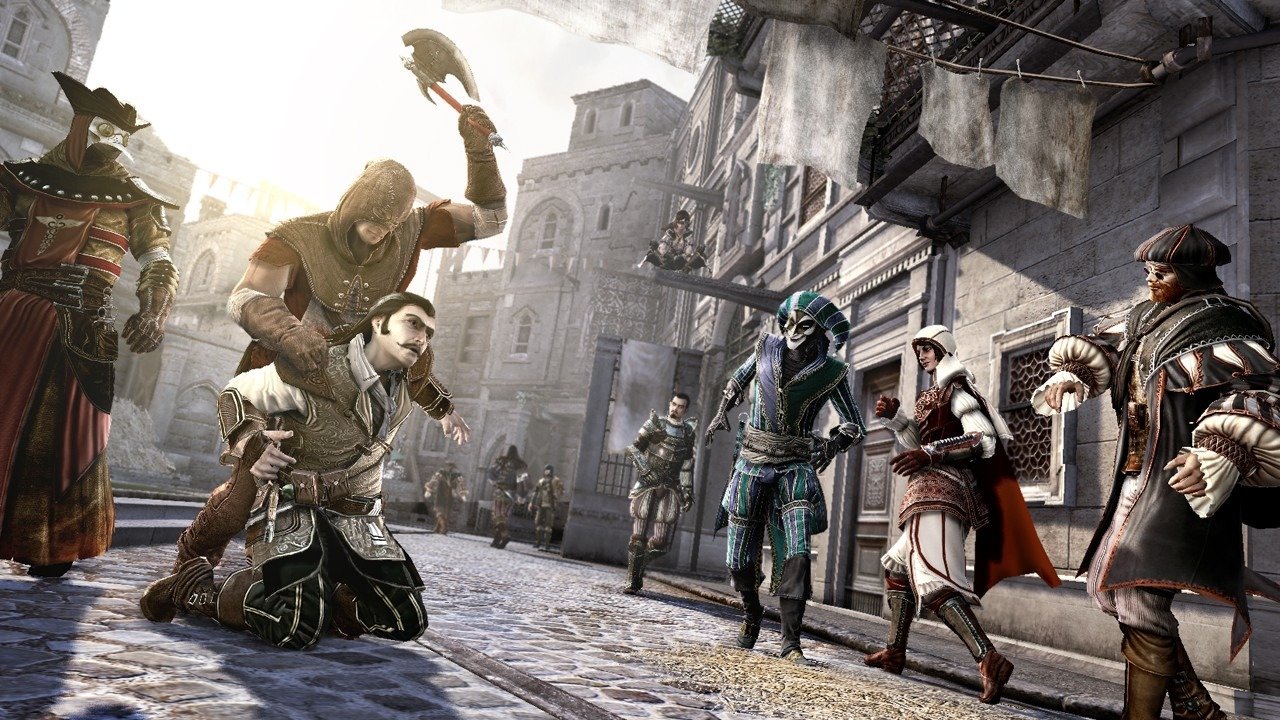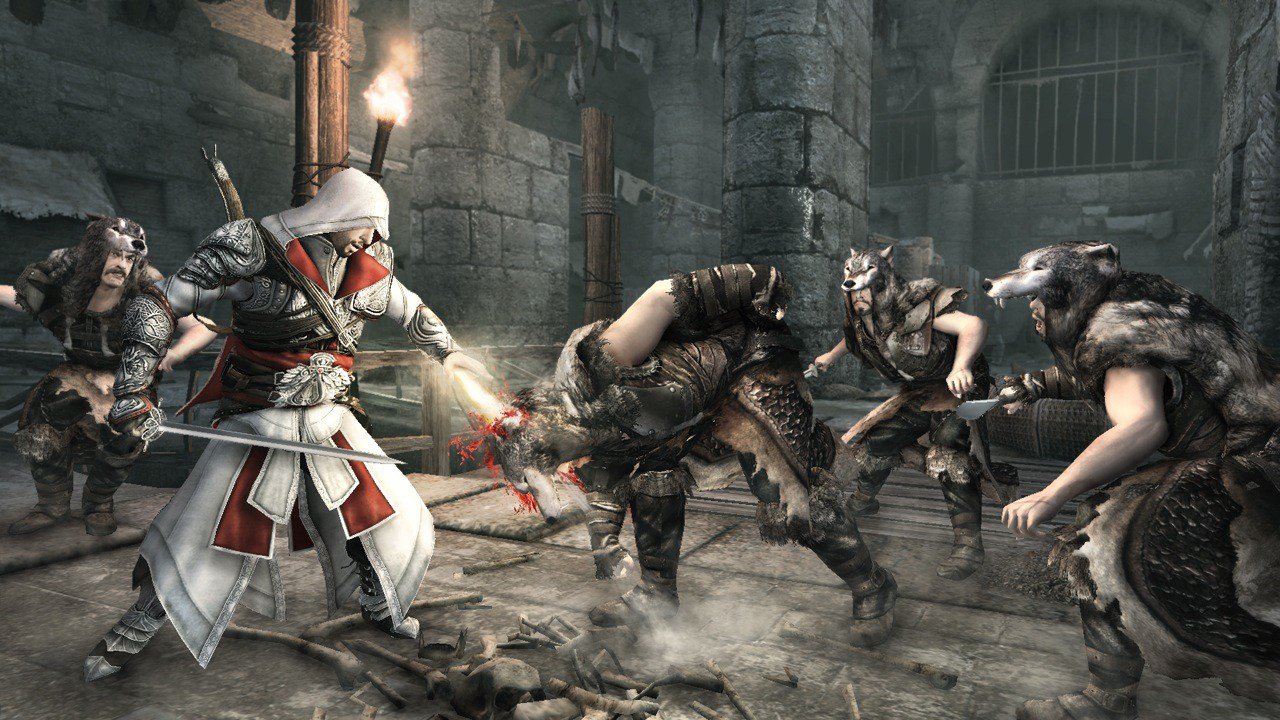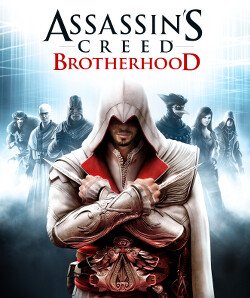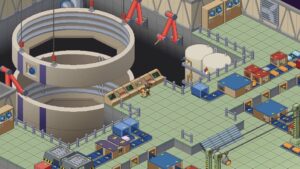Assassin’s Creed: Brotherhood may not shake the series formula, but it sharpens it—and adds one of the most unique multiplayer modes of its generation.
Ubisoft has a unique opportunity with the Assassin’s Creed franchise — a malleable property that can go almost anywhere. And it’s an opportunity the studio is taking advantage of, first by switching characters entirely from one game to the next, and then by introducing an “expansion” to 2009’s Assassin’s Creed II with Assassin’s Creed: Brotherhood. It takes a bold chance by pairing a slower-paced, third-person platformer with multiplayer, and the most surprising thing is that Brotherhood succeeds, though not perfectly.
All Roads Lead To Rome
Brotherhood is a direct follow-up to Assassin’s Creed II, with the story picking up literally moments after the previous game’s ending. A quick video recap catches up newcomers, though it does spoil the discovery and drama of the first two games. Ezio Auditore returns as the historical protagonist, while Desmond Miles continues to uncover ancestral secrets in the present-day narrative — a conspiracy involving Templars and other forces predating humanity itself.
As the story unfolds, what was a narrative barely on the rails in Assassin’s Creed II goes completely off — and up in flames — by the end of Assassin’s Creed: Brotherhood. Players looking for cliff-hangers will be satisfied, but those seeking narrative clarity may be left underwhelmed. Ezio himself lacks a transformative arc this time. The Piece of Eden is stolen — again — and the game is spent recovering it, with little room for character development.

In terms of presentation, Assassin’s Creed: Brotherhood still uses the same engine from Assassin’s Creed II, which isn’t surprising given its release just a year later. It continues to handle large environments beautifully, with detailed characters and animation. However, the ambition of recreating Renaissance Rome — the primary setting — does push the engine.
Screen tearing occurs regularly, frame rates are inconsistent, and textures sometimes load in late. Despite these technical hiccups, it’s a visually striking game with strong art direction. The audio is nearly identical to the previous title, reusing most sound effects and voice actors, with only the music offering notable additions. Brotherhood may not be the technical leap that Assassin’s Creed II was, but its aesthetic design still carries it.
The Brotherhood Wants You
It’s fair to call Assassin’s Creed: Brotherhood “Assassin’s Creed II: Part 2.” Basic gameplay remains unchanged — a mix of parkour-style traversal and parry-based combat — and the controls are identical, which may be a good or bad thing depending on whether you found the series’ semi-automated inputs liberating or restrictive. You’ll still take on missions, tail and assassinate targets, and engage in countless side activities to help “renovate” Rome.
One nice improvement is the increased mission variety and the introduction of “full synchronization” — optional objectives that challenge players to complete missions in specific ways (e.g., taking no damage, avoiding detection). While optional, full sync unlocks cheats and adds finesse for completionists, with trophies and achievements as added incentives. Two major additions stand out: the fight for faction control through Borgia towers and the Brotherhood recruitment system.
Rome is divided into districts controlled by the villainous Borgia family. When they control an area, shops are locked ,and the tunnel system (used for fast travel) is disabled. Killing the area’s commander and burning down the Borgia tower frees the district, unlocking shops, tunnels and income. Though technically optional, ignoring these areas limits your access to healing items and armour repairs.

Recruiting assassins is also a novel addition. As Ezio roams Rome, he’ll encounter oppressed citizens. Helping them recruits them into the Brotherhood, where they can be sent on missions across Europe to gain experience, earn money and retrieve loot. Gained XP upgrades their gear and skills, making them more useful when called to assist during missions. However, perma-death is a factor — sending a low-level recruit on a difficult mission or ignoring their health during combat will result in permanent loss. The system is comprehensive, but ultimately optional; outside of a few story missions, players can complete the campaign without using recruits at all.
The headline feature of Assassin’s Creed: Brotherhood, though, is multiplayer. The core mode, Wanted, is joined by others like Alliance and Manhunt, but all follow the same unique premise: you’re assigned a target to kill, while someone else hunts you. The result is a tense, cerebral game of cat and mouse that blends luck, skill and psychology. It’s immensely satisfying to deceive your hunter by posing as an NPC — or to drop from a rooftop onto your unsuspecting mark. There’s also a levelling system with perks and unlocks, adding longevity and variety. With luck, this twist on multiplayer can lure FPS players out of their comfort zone and into something genuinely fresh.
In the end, Assassin’s Creed: Brotherhood offers a few refinements but is essentially the same game as before. The engine is starting to show its age, but tweaks to gameplay add variety, and the innovative multiplayer mode genuinely brings something new to the table. While it may not offer enough change for everyone, the improvements make it feel distinct enough to justify a return trip to Rome — and a safe purchase for fans.






